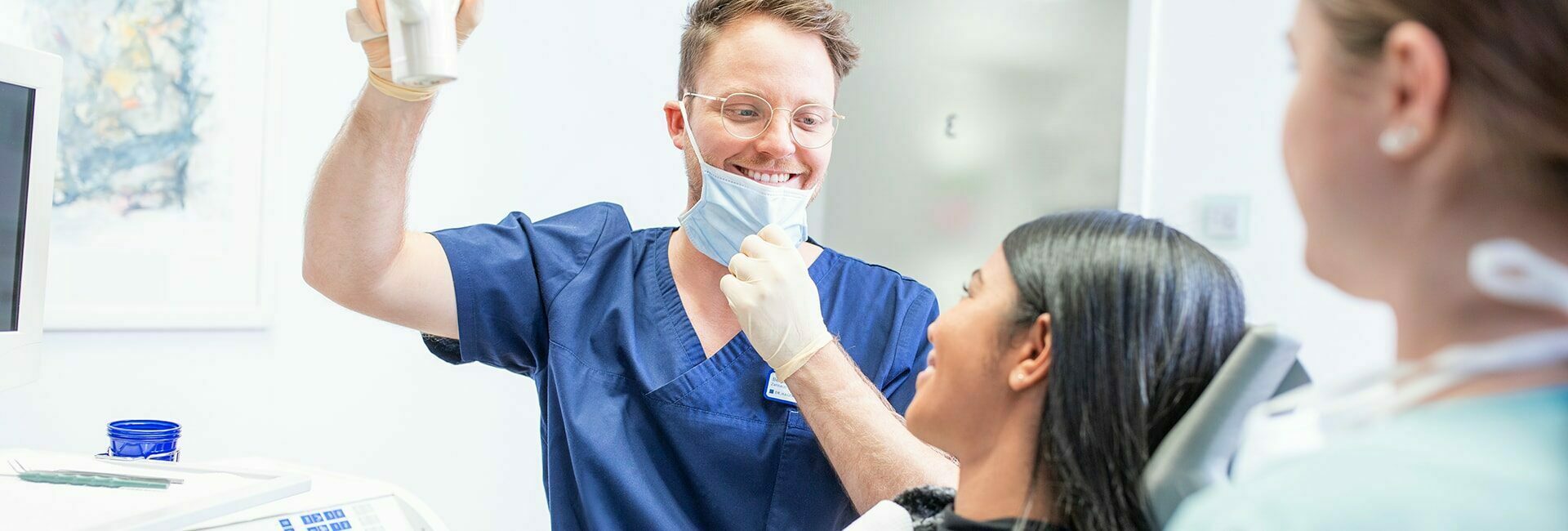
Fear of the dentist
Being afraid of the dentist is very common. For some patients still today, just setting a foot inside a dental practice is a scary experience, and patients can feel very uneasy. Tooth ache is often one of the most unpleasant types of pain a person can experience which is why many people fear pain during treatment. This was clearly demonstrated by a scientific survey that showed 50% of people with an urgent need for treatment would not go into a dental practice for treatment due to being afraid.
Historically, this fear is deeply ingrained in people: only 30 years ago no anaesthesia was used when pulling teeth, removing caries, or performing any other dental procedures. The traumatic experiences of parents are the cause of fear of the dentist. All of this would happen despite the suitable equipment and treatments being available.
A New York surgeon, William Stewart Halsted carried out the first anaesthetic treatments using cocaine as part of dental procedures in as early as 1885. Cocaine, later becoming a widely abused drug, was first used for ophthalmological (eye) treatments. Halsted was the first dentist to apply this pioneering discovery to the field of dental medicine.
It is astonishing that, from that point on and even into the twentieth century, many dentists did not use local anaesthetics.
Where the injections were indeed used, they did not help in reducing patients’ fear of going to the dentists in the past. This is because the syringes, called cannulas, were very thick and themselves caused pain, and with it, fear.
Nowadays, with anaesthetics now used in all dental practices, very thin cannulas (needles) are used, helping to reduce patients’ anxiety about going to the dentist. Furthermore, many new techniques have not been applied to modern dentistry which make treatments easier. These approaches include use of sedation with laughing gas, general anaesthesia, and other methods.
Many patients are still not aware of this, leading to 3 of every 4 people still being afraid of the dentist. Pain is simply expected, and so patients are left bewildered when treatments are carried out completely pain-free.

Gentle application of injections and their effects
By specially applying an anaesthesia technique, the dentists at the Dr. Hager Dental Practice can make patients’ fears disappear from the very start of their appointments. After just a few minutes the effects can be felt, and the local area that is to be treated is anaesthetised, becoming completely numb. It may be interesting to know that any bitter taste in the mouth is not due to the anaesthetic itself, but rather the preservative products sodium sulphide and methylparaben, which mean the anaesthetic can be stored.
Where anaesthesia is required, the effects last for a long time in order to guarantee that no pain is felt for the entire duration of any treatment. It only becomes more difficult for dentists when patients put off visiting the dentist for a long time. This often leads to cases of advanced-stage inflammation. In these cases, it becomes difficult for local anaesthetics to produce their effects on the area. The reason? Inflammation creates a very acidic environment within the tissues, which leads to the effects of the medicines being reduced. For this reason, it is important for patients to see their dentist as soon as they have any signs of pain or discomfort.
In cases where it is too late, and the inflamed region cannot be numbed, the dentist can still help in the majority of cases by prescribing an antibiotic treatment. This treatment is first administered over a rest-period in order to wait for the inflammation to subside. Then the numbing agents will become effective and the causes of the pain can be treated.
We deal with anxious patients on a daily basis in our practices.
For this reason, we take great care to provide gentle, high-quality treatments, being very much aware of patients’ anxiety and fear levels. After finishing treatments, it is a rewarding feeling to see patients reporting on their positive experiences. Indeed, we have noticed that most patients come to us after receiving a recommendation.

„Almost one in two patients is afraid of going to the dentist. This is often due to the unpleasant feeling of tooth ache, or the sight of the dentist’s syringe containing the numbing anaesthetic. We as dentists working at the Dr. Hager Dental Practice have developed an approach to calm patients and reduce their anxiety levels. When we carry out injections, they can hardly be felt and are administered with the utmost care. In more severe cases, we can always offer patients sedation with nitrous oxide (laughing gas). Just a few minutes after taking the gas, you will be able to relax, and all fears and worries will disappear. In our dedicated article, laughing gas sedation, you can find more detailed information on how this treatment can help.”
Benjamin Hager, Dentist at the Dr. Hager Dental Practice
More modern techniques and pain-free procedures for the anxious patient
Nowadays, anxious or fearful patients have many different options when it comes to having their tooth ache treated completely pain-free. Laughing gas (nitrous oxide) can be a great option for many when carrying out dental treatments. Sedation using the gas is offered by more and more dentists as it is easy to administer and leaves anxious patients in a relaxed state. How is nitrous oxide (laughing gas) administered? Laughing gas sedation, also referred to as “light” anaesthesia, is one of the safest and most modern techniques used to allow patients to have treatments that are relaxed and anxiety-free.
Sedation using laughing gas has its roots in the nineteenth century. A major advantage for patients is that they are responsive for the duration of the treatment and do not lose consciousness.
Using a flow meter, specially designed for dentists, the nitrous oxide is first mixed with oxygen (O2 and N2O gas). Subsequently, the mixture of oxygen and nitrous oxide is administered to the patient via a small face mask covering the nose. The face mask also serves to remove any air you breathe out. Following treatment, patients report positive experiences with feelings of being completely relaxed, an improved sense of well-being and having experienced no pain during treatment.
General anaesthesia is also a technique that can be used to overcome an anxious patient’s fear of the dentist. These types are more costly and complicated when compared to using nitrous oxide for treatment of dental caries or inflamed gums, for example.
A first step to take for many patients who fear the dentist looking to overcome their fear is to identify the real reasons for behind it. Fears instilled by parents are often responsible, as these were justified in times gone by where treatments had very little to do with what treatments look like today. As a child, fear of the dentist can be seen as something obvious.
Home remedies such as camomile and other soothing natural products can also be used in the case of anxious patients before their visit.
The DR. HAGER | Dentists take particular care to give consideration to the needs and wishes of anxious patients. It may also help for the individual steps and the treatment process to be explained beforehand for anxious patients to feel more at ease.
Frequently asked questions
Are all treatments at the Dr. Hager Dental Practice that would involve pain always carried out using anaesthetic?
Yes! We attach great importance to the fact that all our dental treatments are carried out using local anaesthetic. This might be treatment for tooth decay (caries), tooth ache, minor surgical procedures… The DR. HAGER | Dentists will always carry out treatment in such a way that the careful treatment process in the affected area is completely pain-free. We use gentler, less invasive techniques to eliminate the causes of tooth ache. Whether it be laughing gas, conduction (regional) anaesthesia, or local anaesthesia: each and every one of our treatment approaches is designed to help patients to overcome their fear of the dentist in the future.
Why do anaesthetic injections not work to deactivate tooth sensitivity?
Patients often suffer from acute inflammation within the tooth, of the gums, or in the jaw, which may already be in an advanced stage. The acidic inflammation environment created sometimes means that ensuring that the area is completely numb is not possible. In these cases, a preceding antibiotic treatment can be used to relieve symptoms in the run up to the main treatment appointment, ensuring that the tooth and/or gums can be completely numbed.
How can the dentist help to reduce feelings of fear or anxiety due to going to the dentist?
Helping patients to overcome their fears of going to the dentist is not always easy, particularly when this is due to past experiences where local anaesthesia was not used. Only 30 years ago it was absolutely not the standard to carry out dental treatments using local anaesthesia. It’s no wonder, then, that this generation has developed major fear and anxiety issues surrounding dentists. Since opening our practices over 35 years ago, the dentists at the Dr. Hager Dental Practice have been using local anaesthesia. To help patients to overcome these fears, we can, on request, discuss all of the treatment steps with patients, helping to make anxiety and fear a thing of the past. The dentists working at both Dr. Hager Dental Practices, in Konstanz and in Bietingen, all put a great deal of effort into resolving dental problems and improving dental hygiene, leaving patients in a good state of dental health. Once we can achieve this, we can ensure that tooth ache becomes a thing of the past for our patients.
What causes tooth ache?
A frequent cause is poor oral hygiene. If dental care is not properly ensured on a daily basis, bacteria are able to attack healthy teeth, leading to dental caries (tooth decay). Bacteria work at the teeth, gradually advancing towards their inner layers. Stimuli such as cold water, sweet foods or acids from fruits can reach closer and closer to the dental nerve, leading to the all-too-familiar toothache. Bacteria can similarly cause inflammation of the gums. In this process, it is possible for bacteria to take hold in the gingival crevices (small pockets in the gums), working their way deeper and deeper towards the dental root. In this case too, toothache occurs.